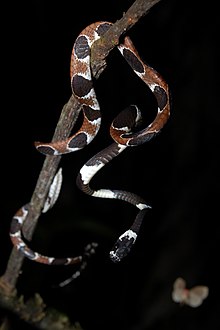Catesby's snail-eater
| Catesby's snail-eater | |
|---|---|

| |
| Scientific classification | |
| Domain: | Eukaryota |
| Kingdom: | Animalia |
| Phylum: | Chordata |
| Class: | Reptilia |
| Order: | Squamata |
| Suborder: | Serpentes |
| Family: | Colubridae |
| Genus: | Dipsas |
| Species: | D. catesbyi |
| Binomial name | |
| Dipsas catesbyi | |
| Synonyms[2] | |
| |
Catesby's snail-eater (Dipsas catesbyi), also commonly known as Catesby's snail sucker,[2] is a nocturnal species of nonvenomous snake in the family Colubridae.[1] The species is native to northern South America.[1]
In June 2021 upon manipulation, a snake of this species presented vocalization, a duration of 0.06 seconds, reaching 3036 Hz in its peak frequency with a modulated note, emitted through exhalation of air through the larynx, being the first record of a snake call in South America.[3][1]
Etymology
The specific name, catesbyi, is in honor of English naturalist Mark Catesby.[4]
Geographic range
D. catesbyi is found in Bolivia, Brazil, Guyana,[5] Colombia, Ecuador, French Guiana, Peru, Suriname, and Venezuela.[6]
Habitat
D. catesbyi lives at altitudes of up to 1,500 m (4,900 ft), in mountainous regions, tropical forests, and lowlands.[1]
Diet
D. catesbyi, like all species in the genus Dipsas, preys on arboreal land snails and slugs.[7]
Reproduction
D. catesbyi is oviparous.[1][6]
References
- ^ a b c d e f Kornacker P, Lehr E, Lundberg M (2010). Dipsas catesbyi. In: IUCN 2012. IUCN Red List of Threatened Species. Version 2012.2.
- ^ a b Peters JA (1956). "An Analysis of Variation in a South American Snake, Catesby's Snail-Sucker (Dipsas catesbyi Sentzen)". American Museum Novitates (1783): 1–41.
- ^ Fernandes, Igor Yuri; Koch, Esteban Diego; Mônico, Alexander Tamanini (2023-10-09). "First record of a snake call in South America: the unusual sound of an ornate snail-eater Dipsas catesbyi". Acta Amazonica. 53 (3): 243–245. doi:10.1590/1809-4392202300431. ISSN 0044-5967.
- ^ Beolens, Bo; Watkins, Michael; Grayson, Michael (2011). "Dipsas catesbyi". The Eponym Dictionary of Reptiles. Baltimore: Johns Hopkins University Press. p. 50. ISBN 978-1-4214-0135-5.
- ^ Cole CJ; Townsend CR; Reynolds RP; MacCulloch RD; Lathrop A (2013). "Amphibians and reptiles of Guyana, South America: Illustrated keys, annotated species accounts, and a biogeographic synopsis". Proceedings of the Biological Society of Washington. 125 (4): 317–620. doi:10.2988/0006-324x-125.4.317. S2CID 86665287.
- ^ a b "Dipsas catesbyi". The Reptile Database. Retrieved 2013-01-03.
- ^ Goin, Coleman J. [in French]; Goin, Olive B.; Zug, George R. [in German] (1978). "Genus Dipsas". Introduction to Herpetology, Third Edition. San Francisco: W.H. Freeman and Company. pp. 149, 329. ISBN 0-7167-0020-4.
Further reading
- Boulenger GA (1896). Catalogue of the Snakes in the British Museum (Natural History). Volume III., Containing the Colubridæ (Opisthoglyphæ and Proteroglyphæ), ... London: Trustees of the British Museum (Natural History). (Taylor and Francis, printers). xiv + 727 pp. + Plates I-XXV. (Leptognathus catesbyi, pp. 449–450).
- Freiberg M (1982). Snakes of South America. Hong Kong: T.F.H. Publications. 189 pp. ISBN 0-87666-912-7. (Dipsas catesbyi, p. 93).
- Marciano-Júnior E, Mira-Mendes CV, Dias IR, Oliveira FFR, Drummond LO (2015). "Dipsas catesbyi (Catesby's Snail-eater). Defensive Behavior". Herpetological Review 46 (4): 643.
- Jan G, Sordelli F (1870). Iconographie générale des Ophidiens, Trente-septième livraison. Paris: Baillière. Index + Plates I-VI. (Leptognathus catesbyi, Plate II, figure 2). (in French).
- Sentzen UJ (1796). "Ophiologische Fragmente, 6. Beschreibung des Coluber Catesbeji". Meyer's Zoologische Archives 2: 66-74. (Coluber catesbeji, new species). (in German).
- Zug, George R.; Hedges, S. Blair; Sunkel, Sara (1979). "Variation in Reproductive Parameters of Three Neotropical Snakes, Coniophanes fissidens, Dipsas catesbyi, and Imantodes cenchoa". Smithsonian Contributions to Zoology (300): 1–20.

